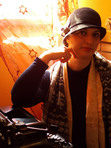Sarah Zama's Blog, page 54
April 13, 2017
Law (1940s Film Noir – #AtoZChallenge)
 The law manifests itself in film noir not just as the legally defined framework of the actual law, but also as the law of patriarchy, which defines the cultural environment. In a traditional world (the world before the WWII) patriarchy – the masculine law – defined the culturally acceptable position (and so the determination) of masculine identity and desires inside a world that was perfectly recognisable by men.
The law manifests itself in film noir not just as the legally defined framework of the actual law, but also as the law of patriarchy, which defines the cultural environment. In a traditional world (the world before the WWII) patriarchy – the masculine law – defined the culturally acceptable position (and so the determination) of masculine identity and desires inside a world that was perfectly recognisable by men.
The postwar years posed many questions about the patriarchal law. When women conquered spaces that never used to be theirs, the male position inside society got questioned. Film noir in fact tends to be structured around the testing of the hero’s prowess, both in terms of ‘professional’ ability and in how he measure up to more extended standards of masculine competency.
Law and a rapresentation of the patriarchal law #FilmNoir anti-hero #AtoZChallenge
Click To Tweet
Depending on how this tasting happens, film noir can be divided into three categories:

He Walked by Night
Investigative thriller
The hero, often an investigative detective, seeks to restore order by exposing and counterminding a criminal conspiracy.
A type of early noir, in these films there is still a sense that the hero can bring that kind of control over society. He needs to fight for it, but eventually he reaffirms himself as keeper of the law (The Maltese Falcon)
Male suspense thriller
The hero is in a position of inferiority, with regard to both the criminal conspirator and the police (he is blackmailed or accused of a crime) and seeks to restore himself to a position of security by eradicating the enigma.
This is a more problematic form of noir, where the position of the hero is always at risk and it’s never sure whether he will succeed in restoring the law and his own identity.
In fact, he often doesn’t. (Out of the Past)
Criminal adventure thriller
The hero, usually with the aid of a woman, becomes engaged in either a wilful or an accidental transgression of the law and has to face the consequences of stepping out of line.
This is probably the more dramatic form of noir, where the sense of desperation is higher. Here the hero finds himself fighting off greater powers, which come from within and without himself, and there’s very little light at the end of the tunnel. (Double Indemnity)

The Dark Corner
The narrational structure transfigures the hero’s position in regards to the law to the hero’s position in regard to the patriarchal law. The definition of the hero as unified subject – as a man with a purpose and attainable desires – becomes increasingly more problematic as the potentialities of the hero to use the law for his own purposes becomes more evanescent.
In the 1940s, many thrillers were marked by a more traumatic struggle to find a place – with regard to masculine myth-making role –against both women’s new power and an ‘alternative’ definition of male identity.
——————————————————————————-
FILMS CITED
The Dark Corner (1946) by Henry Hathaway
When Bradford Galt (Mark Stevens), a tough private investigator, realizes that he’s being followed, he confronts his assailant, a shifty fellow named Fred Foss (William Bendix). Galt’s encounter with Foss leads to a web of intrigue involving prosperous art collector Hardy Cathcart (Clifton Webb) and his young wife, Mari (Cathy Downs). Soon Galt is in over his head — but luckily for him, his tenacious secretary, Kathleen Stewart (Lucille Ball), is on hand to help him out. (Google synopsis)
He Walked by Night (1948) by Anthony Mann and Alfred L. Werker
Roy Morgan (Richard Basehart) is a burglar who listens in to radio police calls, allowing him to stay one step ahead of the cops. After Morgan kills a police officer, Sergeants Brennan (Scott Brady) and Jones (James Cardwell) have little success in putting the clues of the case together. But when Jones is wounded in a shoot-out with Morgan, Brennan employs all facets of detective work, including forensics and informants, to find the elusive and clever criminal. (Google synopsis)
——————————————————————————-
READ MORE ABOUT IT
Krutnik, Frank, In a Lonely Street. Routledge, 1991, London/NYC
Smashwords | Barnes&Nobles | Kobo | iBookStore
And many other stores

The post Law (1940s Film Noir – #AtoZChallenge) appeared first on The Old Shelter.
April 12, 2017
Killers (1940s Film Noir – #AtoZChallenge)
 In the 1940s thrillers, criminal impulses are generally motivated in terms of personal malaise or psychic dysfunction. Any social critique is avoided… at least on the surface.
In the 1940s thrillers, criminal impulses are generally motivated in terms of personal malaise or psychic dysfunction. Any social critique is avoided… at least on the surface.
There were in fact a few characteristics in these films that suggest the hero’s personal experience is actually the figuration of a larger social issue.
Most of these stories are concerned with crime, very often murder. While in previous years crime had been seen as something ‘other’, something ‘outside’ that needs to be controlled, in film noir crime gets very close. The hero himself becomes – willingly or by accident – the criminal, which cause a shift in the way the crime is handled: because the criminal is also the hero, the story delves sometimes very deep in the reasons and especially in the consequences, both psychological and material, of the crime.
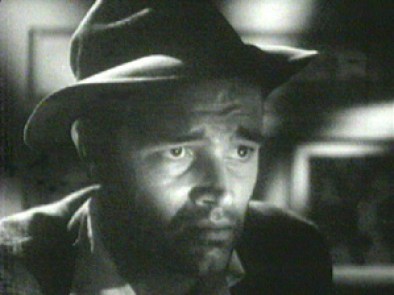
Detour
The inadequacy of the hero as a mover of events becomes central as he get pushed to the crime from many directions.
From the outside, the opportunity is provided by a woman, who first and foremost induces the hero toward an ‘alternative’ world, a transgression that promises to give a new sense to life and, sometimes, a totally new material life. And killing is the ultimate form of transgression.
On the inside, there’s a sense that the action is moved not by the hero’s will, but by some darker, inner impulse inside himself. Even when he decides to go along with the criminal plan, he is very seldom in control of the action, in spite of his every efforts.
In this sense, film noir concerns the disconnection and the confusion of a hero who has lost his centre in the world. It all comes down to his fears and his insecurities and the ways he tries to re-conquer his central place in the world. Which, if it is indeed a personal story, it nonetheless reflects a social issue.
The sense of subject drama is very strong and intensified by the narrational strategies found within these films. Film noir uses in particular two techniques to suggest the hero’s confusion and his position of insecurity:
In 1940s #FilmNoir the hero becomes the criminal and the story is all about his reasons…
Click To Tweet
Flashbacks
This is a common narrative tool in film noir, and while it offers the usual possibility (characteristics of the technique) to fill the viewer in about events which happened before the film started, it also fragmentises the narration. Some films, like The Killers, are built around a very complex structure of flashbacks that shifts point-of-views (and so gives an ununified view of the story) and breaks the narration, forcing the viewer to piece the story together on their own, without an authorative guidance. This reflects the hero’s awkwardness in piecing together the world around him.
Voice over
This is one of the chief characteristics of film noir and one of the places where the divided identity of the hero becomes more apparent. While on the screen, in the flow of the action we see the image of self-confidence and competency the hero gives to the world (since that’s what society expects from him), in the voice over narration he speaks his true heart, his fears and insecurities. In this way the voice over gives us a more complex, more complete and more secret image of the hero.
——————————————————————————-
FILMS CITED
Detour (1945) by Edgar G. Ulmer
In New York, piano player Al Roberts (Tom Neal) laments when his singer girlfriend, Sue Harvey (Claudia Drake), leaves for Hollywood, Calif. When Al gets some money, he decides to hitchhike to California to join Sue. In Arizona, Al accepts a ride with Charles Haskell (Edmund MacDonald), but during a storm in a freak accident, Haskell is killed. Frightened, Al assumes Haskell’s identity and car, but soon comes upon the mysterious Vera (Ann Savage), who seems to know all about his true identity. (Google synopsis)
——————————————————————————-
READ MORE ABOUT IT
Krutnik, Frank, In a Lonely Street. Routledge, 1991, London/NYC
Sillage Critiques – Flashbacks in film noir
Smashwords | Barnes&Nobles | Kobo | iBookStore
And many other stores
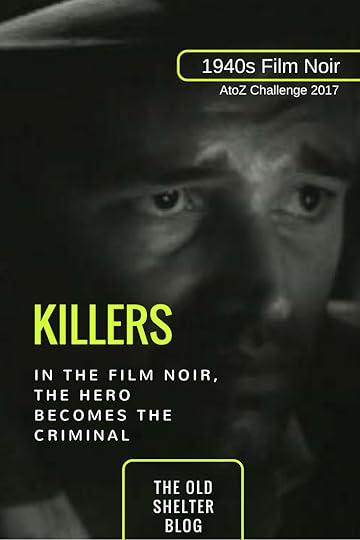
The post Killers (1940s Film Noir – #AtoZChallenge) appeared first on The Old Shelter.
April 11, 2017
Jazz (1940s Film Noir – #AtoZChallenge)
 When I say ‘film noir jazz’ what do you think? A slow, moody kind of jazz, usually with a trumpet solo? I thought you’d say that.
When I say ‘film noir jazz’ what do you think? A slow, moody kind of jazz, usually with a trumpet solo? I thought you’d say that.
Truth is, jazz had basically nothing to do with classic 1940s noir. Jazz was sometimes featured as ambience music, for example from a juke box or in a club, but never in the soundtrack of a film.
The scores for these films were usually modernistic orchestral music, like the well known score of Double Indemnity.
Classic #FilmNoir never used #jazz in their soundtrack. How is it we identify fimn noir with jazz?…
Click To Tweet
Where does the idea comes, then, that jazz is associated with film noir?
It looks like jazz started to be used in film noir (or more exactly, nourish films) in the 1950s, some say in the film (which may or may not be considered noir) A Streetcar Named Desire (1951), from Tennessee William’s play.
Some other trace the beginning of this tradition in a 1958 French film, Elevator to the Gallows (Frantic) which feature a main theme by Miles Davis.
Wherever it came from, jazz association with neo noir is not surprising. The unpredictability, dissonance, experimentation of jazz is particularly apt at commenting these stories of disconnection and confusion.
——————————————————————————-
FILMS CITED
A Streetcar Named Desire (1951) by Elia Kazan
Former schoolteacher Blanche DuBois (Vivien Leigh) leaves small-town Mississippi and moves in with her sister, Stella Kowalski (Kim Hunter), and her husband, Stanley (Marlon Brando), in New Orleans. Blanche’s flirtatious Southern-belle presence causes problems for Stella and Stanley, who already have a volatile relationship, leading to even greater conflict in the Kowalski household. (Google synopsis)
Elevator to the Gallows (1958) by Louis Malle
Florence (Jeanne Moreau) is married to the wealthy arms dealer Simon Carala (Jean Wall), but is carrying on a torrid affair with one of her husband’s employees, Julien (Maurice Ronet). Julien daringly climbs into Simon’s office on a rope, kills him and leaves unnoticed. However, Julien accidentally leaves the rope at the crime scene and realizes he must retrieve it. On his way out, he becomes stuck in the building’s elevator. But he soon finds that his bad luck is just beginning.(Google synopsis)
——————————————————————————-
READ MORE ABOUT IT
All About Jazz – Crimejazz: the sound of noir
Bright Empire – Family Ties
Smashwords | Barnes&Nobles | Kobo | iBookStore
And many other stores

The post Jazz (1940s Film Noir – #AtoZChallenge) appeared first on The Old Shelter.
April 10, 2017
Innuendo (1940s Film Noir – #AtoZChallenge)
 When the popularity of films became apparent in the 1920s as throngs of viewers milled to the motion picture theatres, moralists already started calling for a set of rule. Movies always addressed what people most had at heart and that was often change and fear of change, with all the cutting edge feeling it brought with it. For example, in the 1920s, films were crowded with flappers doing their own, scandalous stuff.
When the popularity of films became apparent in the 1920s as throngs of viewers milled to the motion picture theatres, moralists already started calling for a set of rule. Movies always addressed what people most had at heart and that was often change and fear of change, with all the cutting edge feeling it brought with it. For example, in the 1920s, films were crowded with flappers doing their own, scandalous stuff.
Slowly, a set of rules took form, but it was only in the mid-1930s that this code became prevalent and filmmakers started to adhere to it. The incarnation of the code that informed decades of Hollywood films was the Motion Picture Production Code, also known as Hays Code, from Hollywood chief censor William Hays who strongly upheld it. The code gave a guideline about what was advisable to show in films, which would be ‘play it safe’ on many subjects, including sexuality, violence, graphic showing of any kind. Justice always must prevail. Family always wins over. Patriotism is always rewarded. You get the gist.
It wasn’t mandatory, but once the censorship became strict, filmmakers worried about it butchering their films and looked for ways to go around the code rather than risking to have their products indiscriminately cut by censorship.
The code was upheld in Hollywood from 1935 to 1968.
Censorship could have been the death of #FilmNoir it turned out to be a source of creativity…
Click To Tweet
Film noir, which dominated the 1940s, fell right into one of the harshest periods of ruling of the Hays Code, and being a kind of film that addressed very adult matters and didn’t shy away from themes of violence, murders, betrayals, sexual obsession, censorship was a real issue.
Most film noir solved this not by avoiding the theme, but by avoiding the show, rely on suggestion, innuendo and nudging of the viewer’s imagination. These were valuable means of closing the gap between the constraints bearing upon direct representation and the audience’s expectation of how the characters would actually behave.
In doing so, film noir had two powerful allies:
Freudian psychoanalysis.
This was popularised in the US already in the 1920s, and by the 1940s it was ingrained in people (and of course in movies viewers) to a point that filmmakers could rely on it as part of the narration.
In these popularised account there is a strong association between Freudian psychoanalysis and hidden or illicit sexuality and in film noir this proved useful to suggest what which could not be showed. Instead of showing forbidden activities, seemingly natural elements were introduced which were nevertheless evocative by association or thought symbolism.
Double meaning dialogue was one of the most used devises and indeed one of the most recognised characteristics of noir.
Expressionism
German Expressionism was based on the manipulation of reality so to elicit an emotional response. It uses natural elements, then distorts and manipulates them in a way that suggests very different realities. “Dream sequences” as well as other forms of displaced experience, became very common in film noir. They conveyed in a displaced manner the effects of extreme violence, perverse or corrupted sexuality or moments of psychic breakdown. During the 1940s, and particularly in the crime thrillers, such sequences represent a standardised means of simultaneously signifying and siphoning-off excesses.
The Haye Code could have been a disaster for film noir. It actually became a source of creativity and gave birth to some of the most recognised characteristics of noir.
——————————————————————————-
FILMS CITED
The Big Sleep (1947) by Howard Hawks
Private investigator Philip Marlowe (Humphrey Bogart) is hired by General Sternwood to help resolve the gambling debts of his wild young daughter, Carmen (Martha Vickers). Sternwood’s older daughter, Vivian (Lauren Bacall), provides assistance when she implies that the situation is more complex, and also involves casino owner (John Ridgely) and a recently disappeared family friend. As people linked to the Sternwoods start being murdered, Marlowe finds himself getting ever deeper into the case. (Google synopsis)
Spellbound (1945) by Alfred Hitchcock
When Dr. Anthony Edwardes (Gregory Peck) arrives at a Vermont mental hospital to replace the outgoing hospital director, Dr. Constance Peterson (Ingrid Bergman), a psychoanalyst, discovers Edwardes is actually an impostor. The man confesses that the real Dr. Edwardes is dead and fears he may have killed him, but cannot recall anything. Dr. Peterson, however is convinced his impostor is innocent of the man’s murder, and joins him on a quest to unravel his amnesia through psychoanalysis.(Google synopsis)
——————————————————————————-
READ MORE ABOUT IT
Krutnik, Frank, In a Lonely Street. Routledge, 1991, London/NYC
NPR – Remembering Hollywood’s Haye Code 40 Years On
Urban Dictionary – Haye Code
Smashwords | Barnes&Nobles | Kobo | iBookStore
And many other stores
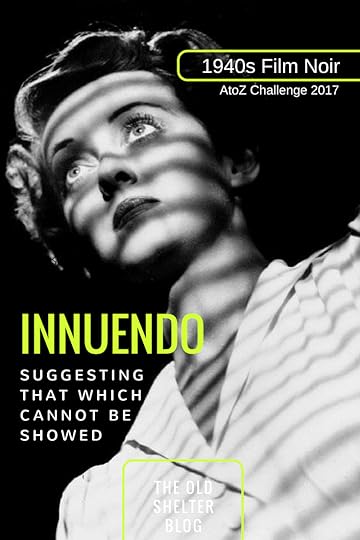
The post Innuendo (1940s Film Noir – #AtoZChallenge) appeared first on The Old Shelter.
April 9, 2017
Hard Boiled (1940s Film Noir – #AtoZChallenge)
 Hard boiled crime fiction was the preferred narrational source for film noir.
Hard boiled crime fiction was the preferred narrational source for film noir.
Born in the lurid pulp magazines of the 1910s, hard boiled crime fiction became one of the most popular form of entertainment (both in fiction and films) from the 1920s to the 1950s.
The most popular of the pulp fiction magazines that offered hard boiled mysteries was Black Mask, which actually started out offering a more classic kind of English-style mysteries, but by the 1920s, it almost only published hard boiled detective stories.
Although the first to write this kind of stories w
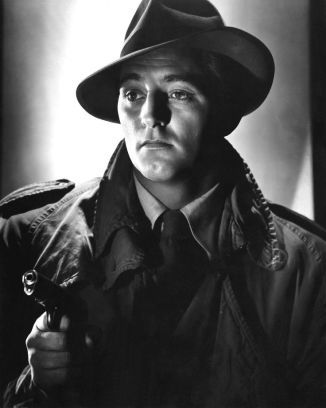
Out of the Past
as Carroll John Daly in 1923, there’s no doubt that the most popular author was Dashiell Hammett. A former Pinkerton detective, he deliberately sought to write against the polite convention of English-style detective stories and he was so successful at it that the magazine actively encouraged more authors to write in the same vain. Both a popular and critical success, Hammett was praised for the realism of his sparse, stripped-down style and for the way he didn’t ‘hold back’ from sex, violence and the seedy side of life.
Hammett’s stories were among the first to be turned into films (in fact, his The Maltese Falcon, the 1941 version, is considered by many critics to be the first film noir), and together with Raymond Chandler he would not only write novels, but also film adaptations of many film noirs of the 1940s.
Hard boiled fiction represent a significant break away from the classic English-style mystery story. At the centre of these classic stories there was a ‘thinking-machine’ detective who enters a particular context in order to solve a crime. The detective doesn’t belong to the world which had been disrupted by the crime, but his abilities allow him to decode the events (and the world itself), solve the mystery and make that world stable again.
Hard boiled writers had a style made to order for the film noir #FilmNoir #AtoZChallenge
Click To Tweet
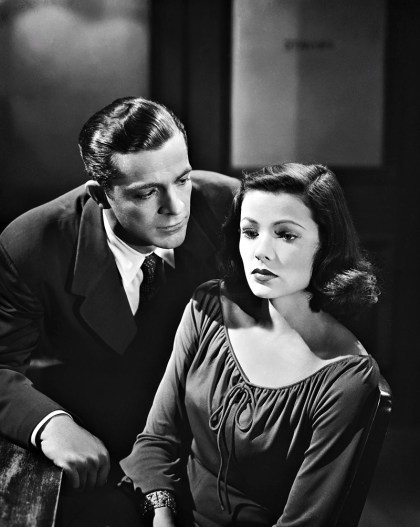
Laura
Hard boiled stories work in a completely different context. The detective is normally part of the world he investigates and is affected by it. The crime often involves the underworld, which is an instable environment on its own. The hard boiled detective is nonetheless able to navigate that world even if he doesn’t belong to it. He is often a mediator between the underworld and the law, but this never brings stability, not event to the story, because of the uncertainties about the hero’s identity: is he as ruthless as he looks like? Is he really ready to do anything or does he have some kind of moral code? And if he does, how does his moral code relate to the accepted social rules?
The hard boiled detective is a lot harder to place than the classic mystery detective.
But this kind of ambiguity was exactly what the 1940s tough thrillers were about, and when Hollywood turned to tough moral themes, the hard boiled school was ready to offer conventions of heroes, minor characters, plots, dialogue and themes. Like the German expatriates, the hard boiled writers had a style made to order for the film noir.
——————————————————————————-
FILMS CITED
Out of the Past (1947) by Jacques Tourneur
Private eye Jeff Bailey (Robert Mitchum) is hired by notorious gangster Whit Sterling (Kirk Douglas) to find his mistress, Kathie Moffett (Jane Greer), who shot him and ran off with $40,000. Jeff traces Kathie to Mexico, but when he meets her he falls in love and willingly becomes involved in an increasingly complicated web of double-crosses, blackmail, and murder. (Rotten Tomatoes synopsis)
Laura (1944) by Otto Preminger
Laura Hunt (Gene Tierney) has been murdered. Tough New York detective Mark McPherson (Dana Andrews) investigates the killing, methodically questioning the chief suspects: Waspish columnist Waldo Lydecker (Clifton Webb), wastrel socialite Shelby Carpenter (Vincent Price), and Carpenter’s wealthy “patroness” Ann Treadwell. The deeper he gets into the case, the more fascinated he becomes by the enigmatic Laura, literally falling in love with the girl’s painted portrait. As he sits in Laura’s apartment, ruminating over the case and his own obsessions, the door opens, the lights switch on, and in walks Laura Hunt, very much alive!(Fandango synopsis)
——————————————————————————-
READ MORE ABOUT IT
Krutnik, Frank, In a Lonely Street. Routledge, 1991, London/NYC
Schrader, Paul. Note on Film Noir. Filmex (First Los Angeles International Film Exposition), Los Angeles, 1971
Cindy Tsutsumi – 1940s American Film Noir
Smashwords | Barnes&Nobles | Kobo | iBookStore
And many other stores
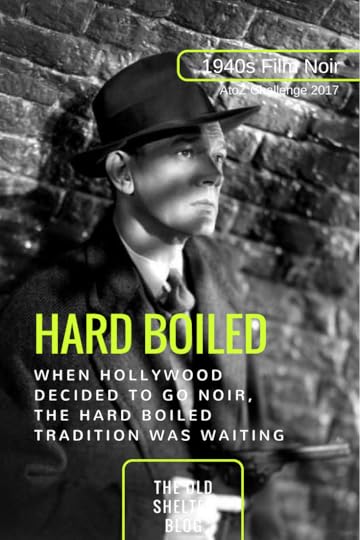
The post Hard Boiled (1940s Film Noir – #AtoZChallenge) appeared first on The Old Shelter.
April 7, 2017
Genre (1940s Film Noir – #AtoZChallenge)
 When we think film noir, we mostly think it is a genre, right?
When we think film noir, we mostly think it is a genre, right?
Well… this is trickier that one would think.
A genre is normally defined as a code of narrational processes familiar to both the creator and the viewer. This is a first very important problem in defining film noir as a genre, since when these films were produced in the 1940s, no filmmaker ever set out to make a film noir and no spectator ever expected to see a film noir – because the concept of film noir didn’t even exist.
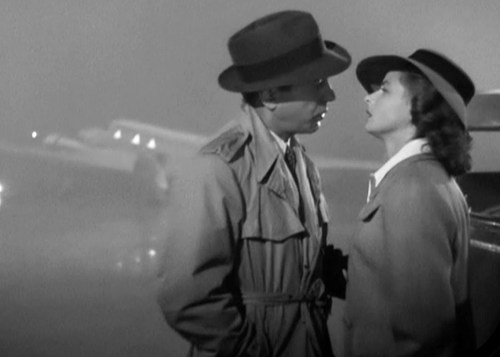
Casablanca
The term film noir (literally ‘black film’) was coined in France after WWII, when French critics first had the opportunity to see the films that had been produced in Hollywood during the war. They noticed a certain new feel to the crime movies of the time, which tended to be grittier, darker, more obsessive then before and to have all very unique common visuals. They called them film noir and the term became familiar in Europe throughout the 1950s, especially after Raymonde Borde and Etienne Chaumenton published their book-length study on the subject in 1955. At that time, almost no film noir was produced in Hollywood anymore. In fact the term film noir entered the common usage in Anglo-American film critique only in the 1960s/1970s with the surge of neonoir.
So we have two problems here:
The term film noir was coin outside of the phenomenon, in a different continent and by critics who had a limited understanding of the film production in Hollywood and could do only unsystematic observations on the subject matter.
The term is retroactive. At the time these films were produced, the term (and so the concept) film noir didn’t exist and so no one could use a recognised generic codification to produce that specific result.
The definition of film noir as a genre has also always been seen as problematic because of its association with 1940s Hollywood. Genre tends to cross periods rather than been bound by them. A western film will be a western whether it is produced in 1910s or in 2010s, because the elements that characterise that genre are definite, recognizable and independent.
But there has always been little agreement on what are the noir characteristics that make a film that specifically kind of film, and therefore, there has always been little agreement on what films can actually be considered noir. For example, can Casablanca be considered noir, or rather a drama with noirish elements?
Indeed most of the writing on film noir stresses its trans-generic manifestations, identifying noir-ish elements in films of another, recognised genre.
Can #FilmNoir be considered a genre? #AtoZChallenge
Click To Tweet
It has then being proposed that film noir could be considered a style. But this definition is problematic as well because it tends to be highly generalised, highlighting sets of features which are by no means specific to film noir. Even if we consider the body of characteristics that does made a film noir, these seems to be more a disparate series of stylistic marking – such as compositional imbalance or chiaroscuro lighting – which can be seen as noir when they occur in conjunction with sets of narrative and thematic conventions and narrational processes. In isolation or even when combined together, they are not specific to film noir, nor to crime cinema, not even to the 1940s.
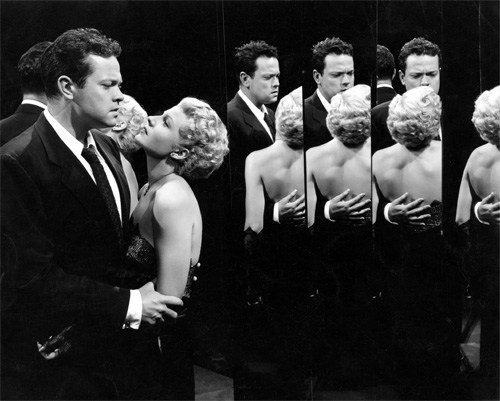
The Lady from Shanghai
What exactly is film noir then? This film form that was occasioned by a series of coincidences and historical circumstances in a particular part of the world, at a very specific time – what is it?
Critics are hard pressed to agree on a definition. But then, we don’t need a definition to enjoy the result.
——————————————————————————-
FILMS CITED
Casablanca (1942) Michael Curtiz
Rick Blaine (Humphrey Bogart), a world-weary ex-freedom fighter, runs a nightclub in Casablanca during the early part of WWII. Despite pressure from the local authorities, notably the crafty Capt. Renault (Claude Rains), Rick’s café has become a haven for refugees looking to purchase illicit letters of transit which will allow them to escape to America. One day, to Rick’s great surprise, he is approached by the famed rebel Victor Laszlo (Paul Henreid) and his wife, Ilsa (Ingrid Bergman), Rick’s true love who deserted him when the Nazis invaded Paris. She still wants Victor to escape to America, but now that she’s renewed her love for Rick, she wants to stay behind in Casablanca. (Fandango Synopsis)
The Lady from Shanghai (1947) by Orson Welles
A seaman, Michael O’Hara (Orson Welles) is hired as a crew member on the yacht of the wealthy Banister (Everett Sloane). His beautiful but mysterious wife Elsa (Rita Hayworth) has met O’Hara earlier, when he saved her from a mugging. What ensues is a complicated and bizarre pattern of deception, fraud and murder, with O’Hara finding himself implicated in a murder, despite his innocence. (AllMovie synopsis)
——————————————————————————-
READ MORE ABOUT IT
Krutnik, Frank, In a Lonely Street. Routledge, 1991, London/NYC
Smashwords | Barnes&Nobles | Kobo | iBookStore
And many other stores
The post Genre (1940s Film Noir – #AtoZChallenge) appeared first on The Old Shelter.
April 6, 2017
Femme Fatale (1940s Film Noir – #AtoZChallenge)
 It is probably no accident that the abundance of film exhibiting the femme fatale coincided with an advancement in the economic and social position of women. In a narrative that is predominantly male, the femme fatale is the predatory woman, the enemy that can’t be considered really an enemy. She’s a threat, but also a fascination. The hero is both scared and attracted by her.
It is probably no accident that the abundance of film exhibiting the femme fatale coincided with an advancement in the economic and social position of women. In a narrative that is predominantly male, the femme fatale is the predatory woman, the enemy that can’t be considered really an enemy. She’s a threat, but also a fascination. The hero is both scared and attracted by her.
What makes the femme fatale so dangerous is that she is outside of male control and in many respects, she plays by her own rules.
She knows exactly what she wants and ruthlessly goes after it with every means she has, including unconventional ones, like deceit and especially sexual control. While the hero finds himself in a place of loss, the femme fatal has everything to gain, which is exactly what makes her so ruthless. Her very existence poses a threat to the traditional order.
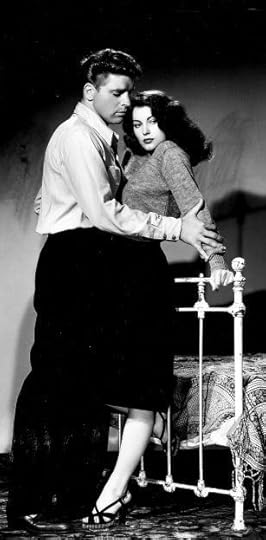
The Killers
This is obviously a reflection of the changing social position of women in postwar America. Women’s new opportunities and expectations are seen as a threat to the traditional sexual roles regimentation as they seek new positions that never used to be available to them.
The femme fatale proposes herself as an alternative to the male world, she seeks the same position as men, and therefore she may end up substituting the male position of control.
In many film noir, the hero becomes so involved with the femme fatale that he does everything she wants, no matter the cost. He doesn’t question her control, but rather he accepts it. In The Killers, Swade willingly takes the blame for Kitty’s wrongdoings. In spite of her obvious duplicity, he is willing to scarify himself for her sake. Even if the narration (and so the perspective of the story) is male, the centre of the story is the woman and her desire. This is clearly and inversion of the traditional sexual role where the man is the mover of events. Film noir both points out the disruption this brings about and the dangerous attitude of men who accept this inversion.
Marital and familiar relationship play a crucial part in ordering the conventional framework of sexual identity and roles, so it’s no surprise that the femme fatale always plays a game against them. She’s the alluring woman, the other man’s woman, even the unfaithful woman. She’s the contrary of everything that is family and steady relationship, which used to be safe places for men in the prewar years.
In the 1940s, there was an attempt at reconstructing these roles after the ‘discursive confusion’ of the war years, as other kinds of films showed, but film noir focused in particular on the uncertainties this redefinition created. Many critics have noted that a large number of noir thrillers are concerned to some degree with the problem represented by women who seek satisfaction and self-definition outside the traditional context of marriage and family.
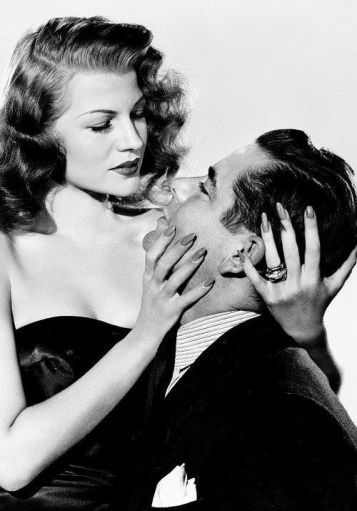
Gilda
Considering the kind of power the femme fatale wields in film noir, the way she’s actually depicted in this films is quite interesting.
In all film noir the femme fatale is extremely eroticised as a character. There is a strong objectification of the woman as body, occurring in a highly formalised, even fetishistic way, that serves to deny her a subjective centreing within the text.
Powerful as she is, she never controls the voice of the narration. Often, we never even learn the reasons for her actions.
This is the result of the perspective of the film being male. We always see her from the outside and by objectifying her, by transforming her in a sexual object of desire (which is particularly easy, since she knows exactly how to use her attractiveness for her purposes) the hero once again tries to encase her in a recognizable position.
Ultimately, she becomes a distant ‘other’, fascinating but inscrutable. As a centre of narration, in the noir thriller she only finds definition in relation to men, and still there is a strong sense of independent meaning to her character. Film noir never let her get away with it, but even when she’s punished, she’s never defeated.
She’s the very incarnation of changin times.
The Femme Fatale, the 'other' of the #FilmNoir #AtoZChallenge
Click To Tweet
——————————————————————————-
FILMS CITED
The Killers (1946) by Robert Siodmark
Two hit men walk into a diner asking for a man called “the Swede” (Burt Lancaster). When the killers find the Swede, he’s expecting them and doesn’t put up a fight. Since the Swede had a life insurance policy, an investigator (Edmond O’Brien), on a hunch, decides to look into the murder. As the Swede’s past is laid bare, it comes to light that he was in love with a beautiful woman (Ava Gardner) who may have lured him into pulling off a bank robbery overseen by another man (Albert Dekker).(Google synopsis)
Gilda (1948) Charles Vidor
Johnny Farrell (Glenn Ford) is a small-time American gambler, newly arrived in Buenos Aires, Argentina. When he is caught cheating at a game of blackjack, Farrell manages to talk his way into a job with the casino’s owner, the powerful Ballin Mundson (George Macready). The two form an uneasy partnership based off their mutual lack of scruples until Mundson introduces Farrell to his beautiful new wife, Gilda (Rita Hayworth), who just happens to be Farrell’s ex-lover. (Google synopsis)
——————————————————————————-
READ MORE ABOUT IT
Krutnik, Frank, In a Lonely Street. Routledge, 1991, London/NYC
Scott Snyder, Personality Disorder and the Film Noir Femme Fatal – University of Georgia
Berkeley Librery University of California – No Place for Women: the Family in Film Noir
Smashwords | Barnes&Nobles | Kobo | iBookStore
And many other stores
The post Femme Fatale (1940s Film Noir – #AtoZChallenge) appeared first on The Old Shelter.
April 5, 2017
Expressionism (1940s Film Noir – #AtoZChallenge)
 At the beginning of the XX century, there spread in Europe a strong sense – especially among young people – that the world needed to change. That change had been held back far too long. In Germany, Expressionism was part of the mobilisation of young intellectuals who refused everything from the past and were bound to sing the praises of modernity: urban life, the fast times, the machines. These artists theorised at the time that Expressionism was universal, that it had always existed since the ancient time, but if we look at it retrospectively we see clearly that it was born in a very specific historical moment and received influences from many different aspects of life which emerged before and after the 1910s. These diverse and sometimes contradicting elements that deposited and merged together, created the kaleidoscopic image and feel of the movement.
At the beginning of the XX century, there spread in Europe a strong sense – especially among young people – that the world needed to change. That change had been held back far too long. In Germany, Expressionism was part of the mobilisation of young intellectuals who refused everything from the past and were bound to sing the praises of modernity: urban life, the fast times, the machines. These artists theorised at the time that Expressionism was universal, that it had always existed since the ancient time, but if we look at it retrospectively we see clearly that it was born in a very specific historical moment and received influences from many different aspects of life which emerged before and after the 1910s. These diverse and sometimes contradicting elements that deposited and merged together, created the kaleidoscopic image and feel of the movement.
Expressionist artists were against any form of Romanticism. They refused the very concept of inspiration and turned to a more intellectual idea of arts that was also action, political involvement. Similarly, they refused the concept of bourgeois, which lifestyle they saw as old and stale, and sought to shock that kind of thinking by bending reality, depicting it in a wildly distorted way for emotional effect.

Faust
One of the areas of art where German Expressionism was stronger was the film industry.
In the Weimar Republic, entertainment was in high demand, especially in big cities. Berlin was the place to be for any performer and play writer, since its theatrical scene was well ahead of many other cities in Germany and abroad. The popularity of the kabaret exploded, an agile form of theatre that allowed the exploration of new themes and techniques and which didn’t take long to appropriate the new expressionistic ideas.
Berlin viewers, as the theatre people, liked experimentation and soon they started to patronise cinemas and demand new featured films. But Germany, that had been isolated all through the 1910s (first because of the war, then because of the feeling of mistrust all nations seem to carry towards her) found herself unable to import films, especially from Hollywood. The solution was starting to produce her own, drowning ideas, but also actual professionals (actors, directors, light technicians) from the theatre. The strong expressionist involvement and experience of Berlin theatre was then transferred to cinema.
German Expressionism disrupted reality for emotional reaction #AtoZChallenge #film
Click To Tweet
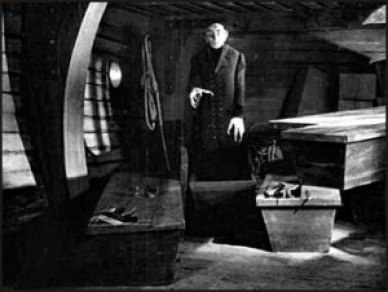
Nosferatu
Not all films produced in Germany in the 1920s were Expressionistic, but most of the more interesting and experimental were.
Expressionistic films would use atmospheric lighting, asymmetrical camera angles and highlight many objects and characters with the use of light contrast. That created that sense of non-objectivity and disconnect that was the prime tool of Expressionism in seeking first an emotional, then an intellectual reaction from its audience.
Coming after a catastrophic military defeat and a failed socialist revolution, the emergence of a national cinema of international fame in Germany was unexpected and exceptional. This industry had to fight many enemies, first of all the shortness of resources. The chronic lack of money, due to the terrible financial situation of Germany (the huge war reparations she was supposed to pay, the hyperinflation) forced many industries, including cinema, to find new, alternative ways to do things. German cinema was a hotbed of innovations in the 1920s, in special effects, set designs, lighting and many other areas. Filmmakers tried to make do with what they had, and Expressionism, which tried to depict reality by disrupting it, proved to be a very important ingredient in this field.
——————————————————————————-
FILMS CITED
Faust (1926) by F.W. Murnau
the demon Mephisto (Emil Jannings) makes a bet with an archangel that a good man’s soul can be corrupted. Mephisto sets his sights on the thoughtful old alchemist Faust (Gösta Ekman), who is desperately trying to save his village from a plague. He is able to help the villagers, thanks to Mephisto, but further dealings with the devil lead Faust on a decadent downward spiral. Can he redeem his soul before it’s too late?.(Google synopsis)
Nosferatu (1922) by F.W. Murnau
he mysterious Count Orlok (Max Schreck) summons Thomas Hutter (Gustav von Wangenheim) to his remote Transylvanian castle in the mountains. The eerie Orlok seeks to buy a house near Hutter and his wife, Ellen (Greta Schroeder). After Orlok reveals his vampire nature, Hutter struggles to escape the castle, knowing that Ellen is in grave danger. Meanwhile Orlok’s servant, Knock (Alexander Granach), prepares for his master to arrive at his new home. (Google synopsis)
——————————————————————————-
READ MORE ABOUT IT
Krutnik, Frank, In a Lonely Street. Routledge, 1991, London/NYC
Paolo Chiarini and Antonella Gargano, La Berlino dell’Espressionismo. Editori Riuniti, Roma, 2001
Cindy Tsutsumi – 1940s America: film Noir
ArtNet News – Art House: An Introduction to German Expressionist Films
Film Inquiry – The Shadow of German Expressionism in Cinema
Cinecollage – Expressionist Films or Weimar Cinema?
FilmISM – Films Techniques of German Expressionism
Smashwords | Barnes&Nobles | Kobo | iBookStore
And many other stores

The post Expressionism (1940s Film Noir – #AtoZChallenge) appeared first on The Old Shelter.
April 4, 2017
Damaged Hero (1940s Film Noir – #AtoZChallenge)
 In many respects, film noir is a male narrative. In spite of a strong female presence (the Femme Fatale), the hero of the noir is always a man and the film always articulates his character arc.
In many respects, film noir is a male narrative. In spite of a strong female presence (the Femme Fatale), the hero of the noir is always a man and the film always articulates his character arc.
He’s a character who, on the outside, manifests coolness and competence, as heros do, but the structure of the story allowed a new face of insecuritites and fears to transpire.
In 1943 film critics noted the emergence of this new kind of hero possessing characteristics that didn’t match what Hollywood had until then proposed as heroic. These characters were anti-intellectual, anti-emotional, pro-action men, almost always singles, very often detectives who were once cops. They tended to be psychologically flawed or wounded, and moved freely between the world of law and the underworld but belonged to neither. Even if they might look morally ambiguous or compromised, they normally adhered to their own code of right and wrong.

Kiss Me Deadly
It can be argued that this hero, though completely different from what audiences were accustome to consider heroic, reflected the uncertainties of the American postwar society.
Film noir spoke of men who, after proving themselves on the war fields, return to a world that not only considers those skills useless, but which is also barely recognisible. They find themselves stuck between two world that no longer exist: the war and a new peacetime society. Try to fit into this new world proved a challenge for these men for many different reasons:
The entry of women in the workforce during the war had changed the social asset of American society irrevocably. Even when women were forced to give up their jobs so that these could be given back to men, it was impossible to erase the empowerment women had experienced and the way this had changed their expectations
The removal of men from the family sphere and the sense of lost time and opportunity this had engendered turned into an uneasy feeling of inadequacy. Men felt threatened by women who stayed home and may have not been faithful to them. Family, which used to be the safest of places, now turned into a ground of renegotiations that men weren’t always ready to face
The exposure to violent testing in the armed services had made many men unfit to peacetime life. Accustomed to a male environment where everyone had to prove their value with their strength, many men found themselves fall short in a contest where violence wasn’t the norm, particularly when they were forced to face the new social position of women.
The old cultural regiment (the one men who left for the war knew) no lenger excisted, and the new one was bewhildering. With the focus on the relationship between the hero and the femme fatale, film noir often displays a marked degree of sexual uncertainty, which stands for a dislocation of men from their former sense to be the movers of culture.
Many of the noir hero’s characteristic echo this displacement. He used to be a cop (that is, a paladin of law and order, a bringer of certainties), but now, in his new liminal position as private eye, he expresses the capability to move between the world of law and the underworld with great ease, and still this never allows him to find his own place. His social position is uncertain and ambiguous.
He’s often in a more or less open opposition to society. The world he lives in isn’t the world he used to know and he refuses to abide to its rules. He prefers to make his own rules and uphold them with whatever strength he possesses.
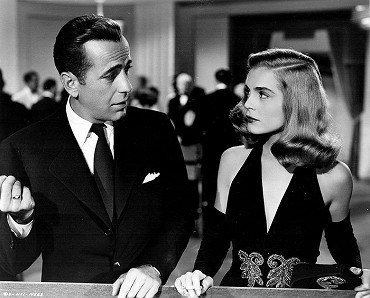
Dead Reckoning
This can be seen in Death Reckoning, where the main character, Rip, assigns many different names to the famme fatale, depending on the role he tries to assign to her. She’s alternatively Coral, Dusty or Mike, not in a progression of morphings, but in a random way.
This shifting of identity (the shifting of names) certainly speaks of the shifting nature of the women’s role, but it also tells the incapability on the hero’s part (on men’s part) to encase her in a determinated role. The same act with which the hero tries to impose his vision of her manifests his inadequacy at doing so.
The noir hero’s position in terms of his centrality (to the story as well as to society) is continuously challenged. He finds himself in the middle of a redefinition of life he feels he can barely control.
What makes these films particularly interesting in terms of the social life they were depicting is the difficulty in this redefinition, which is expressed in the battle of will with the femme fatale. In the end, film noir often fails to convincingly demonstrate a return to male security and supremacy is even possible.
——————————————————————————-
FILMS CITED
Kiss Me Deadly (1955) by Robert Aldrich
One evening, private detective Mike Hammer (Ralph Meeker) picks up a strange woman, Christina (Cloris Leachman), who’s standing on the highway wearing only a trench coat. They’re stopped farther on by strangers who knock out Mike and murder Christina. Although warned not to investigate by the police, Mike and his girlfriend and assistant, Velda (Maxine Cooper), become ensnared in a dark plot involving scientist Dr. Soberin (Albert Dekker) and Christina’s terrified roommate, Lily (Gaby Rodgers).(Google synopsis)
Dead Reckoning (1947) by John Cromwell
In Dead Reckoning, Rip Murdock (Humphrey Bogart) recites the film’s plotline to a priest in the confessional. Murdock and Johnny Drake (William Prince) are Congressional Medal of Honor recipients, en route to Washington by train. Drake hops off and disappears, leading Murdock on a hectic manhunt. Upon meeting Drake’s former girlfriend Coral Chandler (Lizabeth Scott), Murdock is thrown into a maelstrom of intrigue involving a crooked gambler (Morris Carnovsky) and a complex blackmailing scheme. The upshot of this is that Murdock finds himself the prime suspect in a murder. (Rotten Tomatoes)
——————————————————————————-
READ MORE ABOUT IT
Krutnik, Frank, In a Lonely Street. Routledge, 1991, London/NYC
Cindy Tsutsumi – 1940s America: film Noir
Smashwords | Barnes&Nobles | Kobo | iBookStore
And many other stores
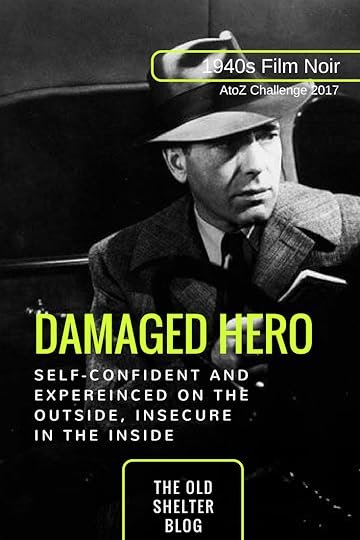
The post Damaged Hero (1940s Film Noir – #AtoZChallenge) appeared first on The Old Shelter.
April 3, 2017
Chiaroscuro (1940s Film Noir – #AtoZChallenge)
 Chiaroscuro is an Italian world that literally means ‘light-dark’ and is a visual technique that was first used by Baroque painters. It was a form of studio lighting that would cast harsh shadow and design volume and forms.
Chiaroscuro is an Italian world that literally means ‘light-dark’ and is a visual technique that was first used by Baroque painters. It was a form of studio lighting that would cast harsh shadow and design volume and forms.
It was later applied to photography and eventually to cinema.
To a certain extent, the use of chiaroscuro in film noir was a necessity. Many of these films where made on a budget and didn’t have a great possibility of using lavish sets. Lighting only a part of the set helped to save money on lighting as well as using shabbier sets that would be concealed by the shadows and only partially revealed by the light when and where needed.
When Hollywood decided to go noir, there were no greater masters of chiaroscuro then the Germans, so it’s no surprise that so many Germans and East Europeans, newly arrived to America as expats, worked on these films.
These cinematographers cast an expressionist shadow on the realistic setting, populating it of oblique and vertical lights and sharp shadows that often came from just one source of light. This created a very specific mood. Oblique lights tend to split the screen, making it restless and unstable.
The actor and the setting were
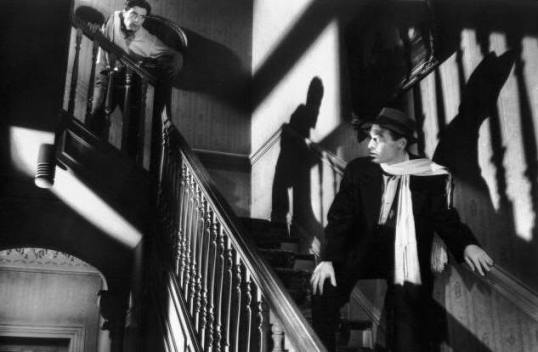
The Stranger on the Third Floor
normally given equal light emphasis, which took away from the characters to give the environment where they moved a greater weight. This created an overwhelming sense of unbalance and uncertainty that perfectly expressed the message of these films.
The Stranger on the Third Floor is a prime example of how chiaroscuro could be used for emotional effects. Cinematographer Nicolas Musuraca creates a world of high light and shadow and uses unique camera angles. His light is deliberatly artificial, it emphasises deep shadows and sharp contrast to create a world that, although perfectly recognizable, also carrys many characteristics of the fantastic.
With chiaroscuro, #FilmNoir turned a limit into one of its strengest points #AtoZChallenge
Click To Tweet
Ultimately, film noir turned its limit into its greatest strength. Born out of necessity, the use chiaroscuro lighting is now one of the most recognizable characteristic of film noir in all its forms.
——————————————————————————-
FILMS CITED
The Stranger on the Third Floor (1940) by Boris Ingster
When upstart journalist Michael Ward (John McGuire) testifies that he saw Joe Briggs (Elisha Cook Jr.) at the scene of a murder, Briggs is jailed and sentenced to death. Later, Michael’s conscience and troubling dreams get the better of him. He tells his girlfriend, Jane (Margaret Tallichet), that he isn’t certain Briggs is guilty. They begin to investigate, but unfortunately, the couple soon makes the acquaintance of an ominous, enigmatic man (Peter Lorre) who wants the case to stay closed. (Google synopsis)
——————————————————————————-
READ MORE ABOUT IT
Schrader, Paul. Notes on Film Noir. Filmex (First Los Angeles International Film Exposition), Los Angeles, 1971
Terry Malloy’s Pigeon Coop – What is… chiaroscuro?
Smashwords | Barnes&Nobles | Kobo | iBookStore
And many other stores
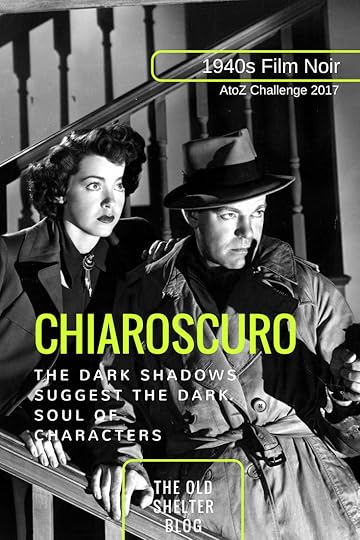
The post Chiaroscuro (1940s Film Noir – #AtoZChallenge) appeared first on The Old Shelter.



